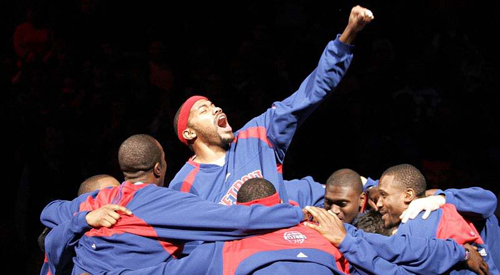
Detroit Pistons: The Team that Earned America’s Patience
A steam whistle bellows through the Palace of Auburn Hills on a dreary March evening, listlessly celebrating a Chris Wilcox field goal from just inside the free-throw line. With a 25-46 record and a roster long expired, it’s a subtle sign that blood – cold as it may be – still flows through the veins of the once-raucous southeastern Michigan crowd.
This isn’t the Detroit Pistons team that sold out 259 consecutive games between 2004 and 2009, and this isn’t the crowd that watched them. What once was the rowdiest stadium in the NBA has been reduced to a warehouse where the fringe stars of yesterday have come to put their motivation in storage.
Just five years ago Chauncey Billups orchestrated a symphony of confidence and swagger in this very building, now in his place, a heavier-set Tracy McGrady obligatorily carries the ball up the floor for no other reason than because he has to. The lunchbox vibe gone, the maniacal fire that burned within Rasheed Wallace stifled. Even Mason lacks the luster that made him the only PA announcer professional sports knew on a last name basis.
Through poor luck and poor management, the Pistons dynasty that yielded five consecutive Eastern Conference Finals appearances between 2003 and 2007 has been dismantled. Though criticism for the Joe Dumars regime is nothing new, the confusion surrounding the inevitable rebuild is frightening.
[php snippet=1]
The most harrowing aspect of the franchise’s demise isn’t that they no longer contend for championships on a regular basis. That the Pistons are paying their dues in the cellar simply signals that the previous era is over, it would be selfish to ask for anything more. What’s tragic is that it’s impossible to comprehend where exactly things went wrong.
The question tugs at the legions of fans once vested in the franchise who obsessively yearn for answers like the surviving family members of plane crash victims contemplating the different ways their loved ones might have perished.
In the end it doesn’t matter, the damage is the same.
Call it the day Ben Wallace abandoned the All-Star platoon that made the Pistons the blue collar envy of the country or when Dumars sent hero Billups to the mountains in exchange for Allen Iverson. Call it the day iconic owner Bill Davidson died at his home in March of 2009, once the soul of an empire that crossed leagues and sports.
The fact that the past is gone doesn’t change the present, the depth chart littered with men more celebrated than necessary is still Detroit’s harsh reality. Dumars’ insistence on approaching free agency like a starving teen approaches grocery shopping has resulted in a payroll with more capable players than spots on the court.
To get behind the veterans that remain from the 2004 championship team is only half the battle. Simultaneously the roster is a throwback to 2005, a glimpse of the future, and a modern day version of the unheralded core that not long ago made them famous.
The Pistons can be aging heros Ben Wallace, Richard Hamilton and Tayshaun Prince or they can be young stars Austin Daye, Jonas Jerebko and Greg Monroe. They can be bold acquisitions Charlie Villanueva, Ben Gordon and Tracy McGrady or neglected contributors Jason Maxiell, Will Bynum and Rodney Stuckey.
What the Pistons can’t seem to be, however, is a unified unit.
It may be years before the Detroit Pistons are back in the spotlight, crashing parties and inspiring America, but until they start grasping at an identity – any identity – they’ll be toiling just as much in irrelevance as in mediocrity.
The Pistons don’t have to start churning out more conference finals appearances to win back their infamously energetic fanbase, they simply have to come to terms with their situation and decide where to go from there.
[php snippet=1]

